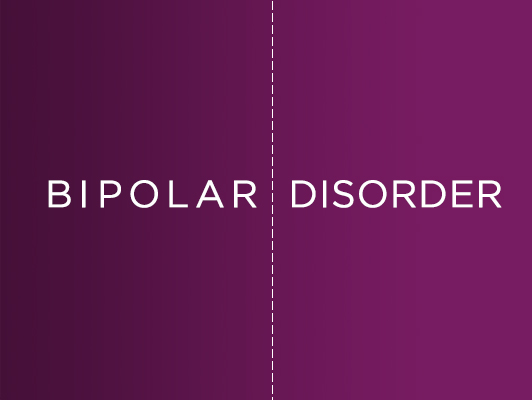Bipolar disorder explained
What is bipolar disorder?
Bipolar disorder is a chronic mood disorder that includes shifts in mood that can be rapid or prolonged. Periods of depression, mania, and stable mood are experienced. The length of time between periods will vary from person to person. These shifts in emotion impact daily functioning, sleep, and activity levels.
A bipolar diagnosis can be categorized into four types:
- Bipolar I:
- Manic episode lasting > 7 days
- Depressive episode lasting > 14 days
- Mixed episodes can occur
- Hospitalization in manic state
- Bipolar II:
- Depressive episode
- Hypomanic episode
- Less severe symptoms
- Cyclothymic disorder
- High frequency of episodes
- Depressive episode lasting > 2 years; 1 year in children
- Hypomanic episode lasting > 2 years; 1 year in children
- Other specified and unspecified bipolar and related disorders
- Symptoms that occur outside of criteria listed above
What do mood episodes look like?
Depression symptoms:
- Decreased energy or activity level
- Feeling hopeless
- Sleeping too little or too much
- Loss of interest
- Feeling worried
- Eating too much or too little
- Thoughts of suicide or death
Manic symptoms:
- Increased energy
- Need less sleep
- Trouble sleeping
- Restless or jumpy
- Rapid speech
- Rapid thoughts or ideas
- Risky behaviors
Proper diagnosis can be difficult! Talk with a health care professional regarding symptoms. For more information on each, click here for additional information.
What causes bipolar disorder?
Different factors can contribute to a bipolar diagnosis. There is not a definitive cause but rather risk factors, including:
- Genetics or family history of bipolar disorder.
- Brain structure.
- Recent stressful or traumatic life events.
- Brain injury.
Statistics on bipolar disorder
- 10 million individuals in the United States have been diagnosed with one of the bipolar disorder types listed above
- A mixed episode can include both manic and depressed symptoms. Hypomania can also occur meaning manic symptoms could be present but less extreme.
What is the treatment for bipolar disorder?
Bipolar disorder can be treated through medication, therapy, and self-help practices.
- Medication: Mood stabilizers, antipsychotics, anticonvulsants, or antidepressants. Talk with your health care professional regarding prescription medications and side effects.
- Therapy: Cognitive-behavioral therapy, talk therapy, psychoeducation
- Self-care: Keeping track of shifts in mood using a journal or app, maintaining medication regimen
Support and resources
Just like a physical condition, a mental health disorder should not define someone. If someone you know is diagnosed with bipolar disorder, take time to ask questions, listen non-judgmentally, and provide support.
- National Institute of Mental Health
- National Alliance on Mental Illness
- National Suicide Prevention Line: 988 or 1-800-273-8255
- Available 24/7
- Calls are confidential




